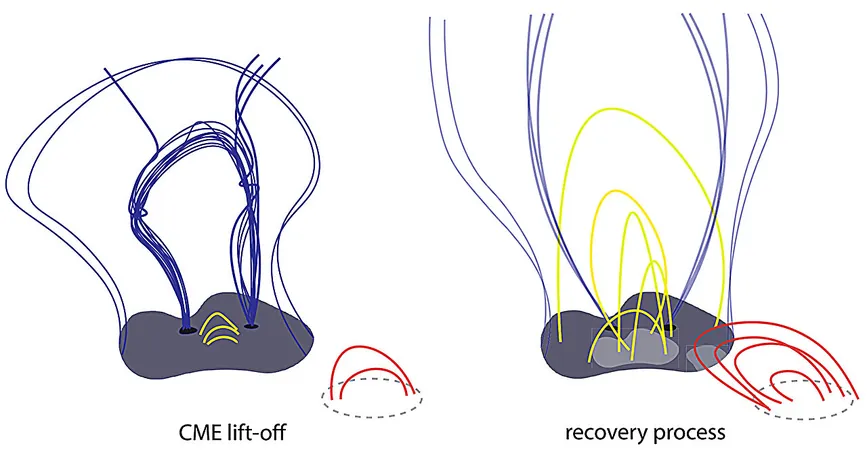
Unveiling the Secret: How the Sun Bounces Back After Plasma Eruptions
2024-11-21
Author: Sarah
Introduction
A groundbreaking research team has uncovered the mechanism by which coronal dimmings—those mysterious dark patches on the sun resulting from powerful plasma eruptions—recover over time. This significant study enhances our understanding of the solar corona's replenishment process following a coronal mass ejection (CME) and its implications for extreme space weather events, especially crucial as we approach the peak of the current solar cycle.
Research Collaboration
Published in the renowned journal Astronomy & Astrophysics, this research brings together experts from various institutions including the Skolkovo Institute of Science and Technology, Politecnico di Milano, NorthWest Research Associates, the University of Graz, and the Kanzelhöhe Observatory.
Understanding Coronal Mass Ejections (CMEs)
Coronal mass ejections are monumental eruptions that can eject billions of tons of magnetic plasma into space, often reaching Earth within mere days. These CME's can trigger severe geomagnetic storms capable of disrupting global communications, navigation systems, and even power grids.
Impact of Extreme Weather Events
Already, in May 2024, an extreme storm event caused significant disruptions, such as rerouted transpolar flights and over 5,000 maneuvers from spacecraft to maintain their orbits. Detecting these potentially hazardous ejections in their early stages poses a challenge. They often go unnoticed until they have matured into fully visible phenomena on coronagraphs designed to mimic a total solar eclipse.
Observing Coronal Dimming
However, scientists are discovering that insight can be gleaned from observing coronal dimmings—dark zones evident in extreme ultraviolet (EUV) images. These areas indicate a depletion of solar material during plasma ejections, providing critical data about the mass, velocity, and trajectory of these cosmic events.
Research Findings
By employing long-term, multi-perspective observations, the research team analyzed the lifespan of these coronal dimmings, revealing essential timing about how the solar corona revitalizes post-CME. "Thanks to high-resolution imagery from the Solar Dynamics Observatory (SDO) and STEREO spacecraft, we can now observe coronal loops successfully expanding and brightening over these dimmed regions after CME eruptions," stated Giulia Ronca, the lead author of the study and a graduate student from Politecnico di Milano, who participated in an Erasmus exchange program at Skoltech.
Importance of Comprehensive Observation
Galina Chikunova, a study co-author and Skoltech Ph.D. alumna, emphasized the importance of viewing solar activity comprehensively: "We aim to extract maximal information from the solar images captured by various satellites to unveil unexpected relationships. Our findings show that the disappearance of dimmings frequently occurs more quickly than what we previously anticipated."
Role of Coronal Loops
Elucidating the process further, Skoltech Associate Professor Tatiana Podladchikova described the role of coronal loops—structures that emerge in active solar regions, continuously forming and dissipating in the upper layers of the corona. "These loops may be less luminous than their surroundings, making them harder to detect, yet they play a pivotal role in accelerating the recovery of dimmings," she explained.
Conclusion
This pivotal study not only enhances our understanding of solar dynamics but also sheds light on the nature of eruptive solar phenomena. As researchers delve deeper into the sun’s stormy temperament, these findings hold profound implications for how we prepare for and respond to the increasingly frequent space weather disruptions in our modern world.
Future Research
Stay tuned as we continue to unravel the solar secrets that may one day protect our technological advances from the wrath of cosmic events!


 Brasil (PT)
Brasil (PT)
 Canada (EN)
Canada (EN)
 Chile (ES)
Chile (ES)
 España (ES)
España (ES)
 France (FR)
France (FR)
 Hong Kong (EN)
Hong Kong (EN)
 Italia (IT)
Italia (IT)
 日本 (JA)
日本 (JA)
 Magyarország (HU)
Magyarország (HU)
 Norge (NO)
Norge (NO)
 Polska (PL)
Polska (PL)
 Schweiz (DE)
Schweiz (DE)
 Singapore (EN)
Singapore (EN)
 Sverige (SV)
Sverige (SV)
 Suomi (FI)
Suomi (FI)
 Türkiye (TR)
Türkiye (TR)